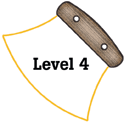
Alaska Science
Key Element D3
 |
Alaska Science |
|
Performance Standard Level 4, Ages 15–18
|
|
|
|
Sample Assessment Ideas
|
Standards Cross-References
|
||
|
National Science Education Standards Identify a problem or design an opportunity. Students should be able to identify new problems or needs and propose ways to change and improve current technological designs. (Page 192) Propose designs and choose between alternative solutions. Students should demonstrate thoughtful planning for a piece of technology or technique. Students should be introduced to the roles of models and simulations in these processes. (Page 192) Implement a proposed design. A variety of skills can be needed in proposing a solution depending on the type of technology that is involved. The construction of artifacts can require the skills of cutting, shaping, treating, and joining common materials such as wood, metal, plastics, and textiles. Solutions can also be implemented using computer software. (Page 192) Evaluate the solution and its consequences. Students should test any solution against the needs and criteria it was designed to meet. At this stage, new criteria not originally considered may be reviewed. (Page 192) |
Benchmarks In designing a device or process, thought should be given as to how it will be manufactured, operated, maintained, replaced, and disposed of and who will sell, operate, and take care of it. The costs associated with these functions may introduce yet more constraints on the design. (Page 52) |
|
Table of Contents | Return to Alaska Native Knowledge Network